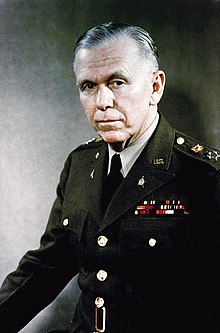General George C. Marshall
|
General of the Army George Marshall |
|
|---|---|
 |
|
| 3rd United States Secretary of Defense | |
|
In office September 21, 1950 – September 12, 1951 |
|
| President | Harry S. Truman |
| Preceded by | Louis A. Johnson |
| Succeeded by | Robert A. Lovett |
| 50th United States Secretary of State | |
|
In office January 21, 1947 – January 20, 1949 |
|
| President | Harry S. Truman |
| Preceded by | James F. Byrnes |
| Succeeded by | Dean G. Acheson |
| United States Special Envoy to China | |
|
In office December 15, 1945 – January 1947 |
|
| President | Harry S. Truman |
| 15th United States Army Chief of Staff | |
|
In office September 1, 1939 – November 18, 1945 |
|
| President |
Franklin D. Roosevelt Harry S. Truman |
| Preceded by | Malin Craig |
| Succeeded by | Dwight D. Eisenhower |
| 10th President of the American Red Cross | |
|
In office October 1, 1949 – December 1, 1950 |
|
| President | Harry S. Truman |
| Preceded by | Basil O'Connor |
| Succeeded by | E. Roland Harriman |
| Personal details | |
| Born |
George Catlett Marshall, Jr. December 31, 1880 Uniontown, Pennsylvania, U.S. |
| Died | October 16, 1959 (aged 78) Walter Reed Hospital Washington, D.C., U.S. |
| Political party | Nonpartisan |
| Spouse(s) |
Elizabeth Carter Coles (m. 1902; her death 1927) Katherine Boyce Tupper Brown (m. 1930; his death 1959) |
| Alma mater | Virginia Military Institute |
| Profession |
|
| Religion | Episcopalian |
| Awards |
Army Distinguished Service Medal (2) Silver Star Nobel Peace Prize Knight Grand Cross of the Order of the Bath (United Kingdom) Legion of Honour (France) World War I Victory Medal World War II Victory Medal Croix de Guerre (France) Congressional Gold Medal |
| Signature |  |
| Military service | |
| Allegiance |
|
| Service/branch |
|
| Years of service | 1902–1959 |
| Rank |
|
| Unit |
|
| Commands |
5th Brigade, 3rd Infantry Division Fort Moultrie and District I, Civilian Conservation Corps 8th Infantry Regiment 15th Infantry Regiment |
| Battles/wars |
Philippine–American War |
|
College football career |
|
| Position | Tackle |
| Career history | |
| College | VMI (1900) |
| Career highlights and awards | |
Philippine–American War
World War I
George Catlett Marshall, Jr. (December 31, 1880 – October 16, 1959) was an American statesman and soldier. He was Chief of Staff of the United States Army under presidents Franklin D. Roosevelt and Harry S. Truman, and served as Secretary of State and Secretary of Defense under Truman. He was hailed as the "organizer of victory" by Winston Churchill for his leadership of the Allied victory in World War II.
Born in Uniontown, Pennsylvania, Marshall was a 1901 graduate of the Virginia Military Institute. After serving briefly as commandant of students at the Danville Military Academy in Danville, Virginia, Marshall received his commission as a second lieutenant of Infantry in February, 1902. In the years after the Spanish-American War, he served in the United States and overseas in positions of increasing rank and responsibility, including platoon leader and company commander in the Philippines during the Philippine–American War. He was the Honor Graduate of his Infantry-Cavalry School Course in 1907, and graduated first in his 1908 Army Staff College class.
In 1916 Marshall was assigned as aide-de-camp to J. Franklin Bell, the commander of the Western Department. After the United States entered World War I, Marshall served with Bell while Bell commanded the Department of the East. He was assigned to the staff of the 1st Division, and assisted with the organization's mobilization and training in the United States, as well as planning of its combat operations in France. Subsequently assigned to the staff of the American Expeditionary Forces headquarters, he was a key planner of American operations including the Meuse-Argonne Offensive.
...
Wikipedia
